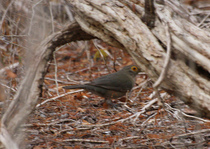Bare-eyed Robin
The similar but allopatric Ecuadorian Thrush was formerly considered a subspecies of the Bare-eyed Thrush and named T. n. maculirostris; it is now normally separated as a good species T. maculirostris. It has a narrower eyering and is only found in forest and woodland in western Ecuador and northwestern Peru.
The Bare-eyed Robin is classified as Least Concern. Does not qualify for a more at risk category. Widespread and abundant taxa are included in this category.
becomes Bare-eyed Robin, to avoid confusion with the English name of an extralimital thrush. Note also the correction of "Turquoise-browned Motmot" (p. 371, typographical error) to "Turquoise-browed Motmot." The preferred citation for the 6th edition (p. ii) is incomplete for bibliographic purposes; it should also list as publisher "American Ornithologists' Union, Washington, D.C." (Alien Press� Lawrence� Kansas, is the printer). Recently published papers proposing taxonomic changes (e.g. More
Bare-eyed Robin might be used in the Caribbean guide, I have never heard a birder calling it anything but thrush in mainland South America (where the vast majority of its range is). Indeed, Hilty doesn't even mention "Bare-eyed Robin" as a secondary name in his Venezuela guide. Anyway, if someone needs an argument for learning scientific names I think this could be the one! - Last edited by Rasmus Boegh : Friday 3rd February 2006 at 15:37. More
Bare-eyed Robin More

Original source: Mark Stevens
Author: Mark Stevens
Permission: Some rights reserved
Family : Turdidae
Genus : Turdus
Species : nudigenis
Authority : Lafresnaye, 1848

